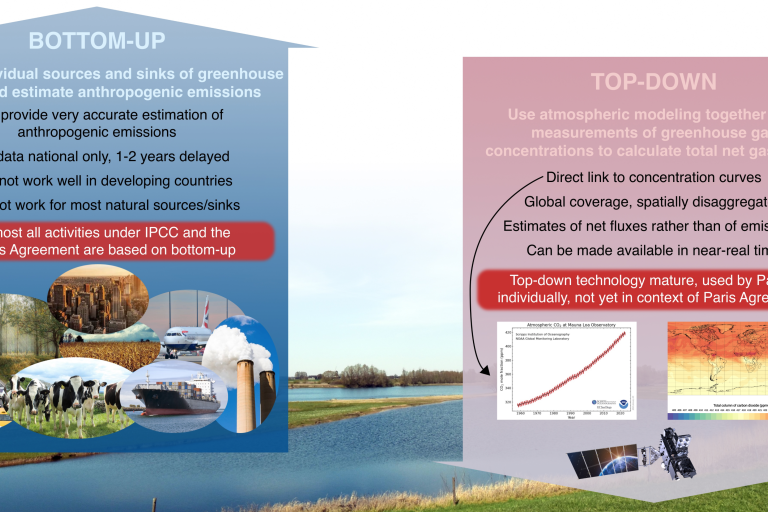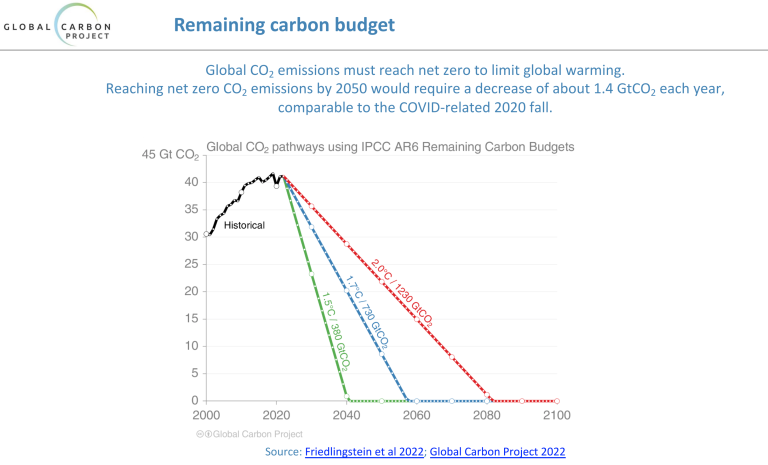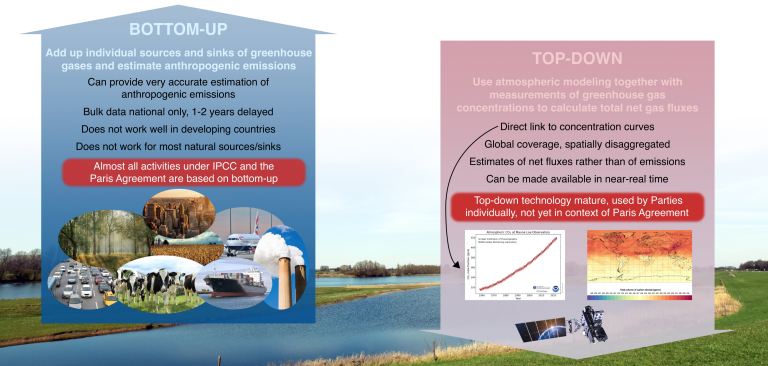Global Greenhouse Gas Watch
Successful implementation of the Paris Agreement of the United Framework Convention on Climate Change (UNFCCC) will require sustained, near-real time monitoring of greenhouse gas (GHGs) fluxes and concentrations to assess the impact and overall effectiveness of mitigation efforts undertaken by the Parties to the agreement.

As the Paris Agreement concerns actions that can be implemented by nations, it largely focuses on the evaluation of the part of GHGs that are directly under the human control, namely anthropogenic emission. These are estimated using a bottom-up approach or inventory which combines activity data and emission factors. The resulting emission estimates are generally considered to be of good quality in industrialized countries, where good national statistics on economic activities is available as a basis. However, in many developing countries, the underlying data required for bottom-up emission estimations are not available.
 Sixty years of growth in background atmospheric CO2 concentrations
Sixty years of growth in background atmospheric CO2 concentrations

The impact of GHGs on climate is driven not only by the anthropogenic emissions, but rather by the total net fluxes (the balance between fluxes in and out of the atmosphere) that control atmospheric concentration. Natural sources and sinks of greenhouse gases, many of which are associated with even larger fluxes than those resulting from human activities, are typically not included in bottom-up estimation.
This leads to continued uncertainty about some of the processes behind the continued rise in atmospheric concentration of GHGs, about the effectiveness of various kinds of mitigation action, and about how the natural sources and sinks of GHGs may respond to the ongoing climate change. In view of these shortcomings, and in recognition of WMO experience with weather and climate monitoring and prediction and GHG research, the Greenhouse Gas Monitoring Symposium held at WMO headquarters at the beginning of the year, issued a call for WMO to take the lead in coordinating an international effort to establish systematic GHG monitoring in support of the implementation of the Paris Agreement.
Unlike emission inventory or bottom-up emission estimates, the top-down approach directly uses atmospheric observations in conjunctions with modelling and data assimilation for estimating when and where GHGs enter and exit the atmosphere. The models, data assimilation, observing network and data exchange that are required for GHG monitoring have much in common with their parallels in the World Weather Watch (WWW), which has been successfully operated by the WMO Members for 60 years. Furthermore, WMO has long-standing GHG activities – monitoring, research and provision of related services under the auspices of the Global Atmosphere Watch (GAW) established in 1989 and its Integrated Global Greenhouse Gas Information System (IG3IS) – on which GHG monitoring can build.

The role of WMO
The proposed Global Greenhouse Gas Watch (G3W)1 will provide global fields of the net fluxes of the main GHGs, and Parties to the Paris Agreement and other interested stakeholders can use these data to develop products that meet their specific requirements. Analogous to its role in the WWW and GAW, the role of the WMO in G3W will be to establish:
- Requirements for an integrated surface-, aircraft and satellite-based observing system
- A design of a comprehensive surface-based observing system
- Improved and timely exchange of all satellite-, aircraft and surface-based GHG observations, including the coordinated planning for future satellite observing systems
- Collaboration on common methodologies and practices for GHG modelling and data assimilation
- Common file formats and practices for exchange of model fields
- Common verification and validation methods
- Common guidance on methods for post-processing and down-stream applications.
WMO will also aim to strengthen research component to continuously support and improve the proposed operational infrastructure. The G3W itself will build on mature research, but additional research will be needed to address several open scientific questions related to surface fluxes and transport uncertainty. Given the need to significantly expand the observational infrastructure, research and development of improved and more cost-effective measurement techniques will also be important.
WMO will also ensure that the implementation of the G3W is accompanied by a comprehensive capacity development and training programme. Staff in various functions – managerial level, operators, data managers, modellers – will require targeted training before, during and after the roll-out.
Configuration and deliverables
The G3W will consist of four main components in its initial configuration:
- A comprehensive sustained, global set of surface-based and satellite-based observations of concentrations, total column amounts, partial column amounts, vertical profiles and fluxes of the main GHGs – carbon dioxide (CO2), methane (CH4) and nitrous oxide (N2O), which together account for 90% of the radiative forcing on the climate system – and of supporting meteorological, oceanic and terrestrial variables; these data will be internationally exchanged as rapidly as possible, pending capabilities and agreements with the system operators.
- Prior estimates of GHG emissions based on activity data and process-based models.
- A set of global high-resolution atmospheric models predicting greenhouse gas concentrations.
- Associated with the models (item 3), data assimilation systems that optimally combine the observations with model calculations to generate estimates of net greenhouse gas fluxes into or out of the atmosphere.
The individual model systems taking part in the G3W will each deliver at least the following outputs in common standard formats:
- Monthly CO2 net fluxes between the Earth surface and the atmosphere with 1° x 1° horizontal resolution delivered with maximum a delay of one month
- • Monthly CH4 net fluxes between the Earth surface and the atmosphere with 1° x 1° horizontal resolution delivered with a delay of one month
- • 3-Dimensional fields of CO2 and CH4 abundance with hourly resolution and data latency to be defined (tentatively on the order of a few days)
- • N2O abundances and net fluxes with resolution and latency still to be defined.
For the G3W, the target resolution of the output would be initially at 1° x 1° (approximately 100 x 100 km at the equator), although some of the participating model systems may operate at higher resolution depending on their individual capacity. These data can then be further processed into a downstream cascade of products to support applications at larger or smaller scales and for individual sectors. But note that while these applications will depend on and build on G3W output, the development of the downstream products themselves is beyond the scope of the initial implementation of G3W.
It will be critical that the input observations meet accuracy and precision standards and that their characteristics be documented per the WMO Integrated Global Observing System (WIGOS) Metadata Standard. As the natural sources and sinks that help determine GHG concentration are often much more distributed in space and have different temporal variability than the anthropogenic sources, the system should also provide adequate spatial coverage and sensitivity to detect changes in natural terrestrial and ocean fluxes, associated with possible carbon-climate feedbacks.
The detailed requirements for the observations will be further refined using the WMO Rolling Review of Requirements process once the G3W moves to the implementation. These requirements will be largely driven by the desired quality of the model output. A core principle in the G3W concept is that all participating modelling centres must be provided access to the same distributed set of input data. However, data selection, pre-processing and data management will be specific to each system/centre due to differences between their individual setups.
The total cost of the fully deployed observing system cannot be credibly estimated at this point. The full network design will not be known until the G3W has moved to implementation. Rather than drastically expanding the observational capabilities, the most important initial step for the G3W will be to establish adequate timely international exchange of all already existing GHG observations, both surface- and space-based.

Top-down monitoring combines observations of atmospheric greenhouse gas concentrations with atmospheric modelling to estimate net fluxes.
Tackling the uncertainties
“The increase in CO2 levels from 2020 to 2021 was higher than the average growth rate over the past decade and methane saw the biggest year-on-year jump since measurements started,” said WMO Secretary-General Professor Petteri Taalas. “But there are still uncertainties, especially regarding the role in the carbon cycle of the ocean, the land biosphere and the permafrost areas. “We therefore need to undertake greenhouse gas monitoring within an integrated Earth System framework in order to be able to account for natural sources and sinks, both as they currently operate and as they will change as a result of a changing climate.”
The proposed G3W will provide a wealth of quantitative data to help improve our understanding of GHG cycles. CGMI will consolidate existing measurement and analysis capabilities to provide estimates of total net GHG fluxes on a global scale at a relatively high resolution in space and time. Improved understanding of GHG fluxes will allow for better prediction of long-term climate trajectories, with potentially strong implications for the mitigation activities required here and now.
”There is very strong support from the science community and private sector for the concept of a global greenhouse gas monitoring infrastructure. WMO has been contacted by both philanthropies and venture capitalists who are seeking opportunities to catalyze a major global extension of greenhouse gas monitoring capabilities, and by a variety of entities involved in the trading of carbon offsets who are looking at the top-down approach as a way to stabilize the carbon trading market by helping to provide a robust and realistic assessment of impact of offsetting,” said Dr Lars Peter Riishojgaard, Deputy Director, WMO Infrastructure Department.
____________
1 This article offers a brief overview of the material available in the Annex to draft Resolution 3.2(2) of the 19th Session of the World Meteorological Congress entitled A WMO-Coordinated Global Greenhouse Gas Monitoring Infrastructure. The expert community is encouraged to read the document for more complete information.










